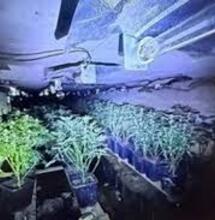Interview with Sweet Seeds

The Spanish Sweet Seeds, a seed bank specialising in feminised seeds, conquered first Spain and then went on the conquer the whole of Europe. The secret of this seed bank is that they're close to the grower and they have a good nose for what the public wants: in the first place of course, feminised quality seed for an outstanding price. As well as that, Sweet Seeds offers a number of unique package deals, such as special Collectors Editions with three different varieties per package, or the possibility of putting together a combination of different strains one's self. Sweet Seeds is one of the first seed banks to plunge in to autoflowering varieties, a section in the catalogue that is still being developed. Before the lads from Sweet Seeds began their company they were growers themselves, who out of dissatisfaction with what was on offer decided to tackle things quite differently. Undoubtedly, their customers are grateful to the guys, and that is proven by the rapid growth of the company and the many prizes with which Sweet Seeds varieties have been crowned in various cannabis competitions. Meanwhile, the seed bank has been steaming full ahead...
The Spanish Sweet Seeds, a seed bank specialising in feminised seeds, conquered first Spain and then went on the conquer the whole of Europe. The secret of this seed bank is that they're close to the grower and they have a good nose for what the public wants: in the first place of course, feminised quality seed for an outstanding price. As well as that, Sweet Seeds offers a number of unique package deals, such as special Collectors Editions with three different varieties per package, or the possibility of putting together a combination of different strains one's self.
Sweet Seeds is one of the first seed banks to plunge in to autoflowering varieties, a section in the catalogue that is still being developed. Before the lads from Sweet Seeds began their company they were growers themselves, who out of dissatisfaction with what was on offer decided to tackle things quite differently. Undoubtedly, their customers are grateful to the guys, and that is proven by the rapid growth of the company and the many prizes with which Sweet Seeds varieties have been crowned in various cannabis competitions. Meanwhile, the seed bank has been steaming full ahead...
The Spanish Sweet Seeds, a seed bank specialising in feminised seeds, conquered first Spain and then went on the conquer the whole of Europe. The secret of this seed bank is that they're close to the grower and they have a good nose for what the public wants: in the first place of course, feminised quality seed for an outstanding price. As well as that, Sweet Seeds offers a number of unique package deals, such as special Collectors Editions with three different varieties per package, or the possibility of putting together a combination of different strains one's self.
Sweet Seeds is one of the first seed banks to plunge in to autoflowering varieties, a section in the catalogue that is still being developed. Before the lads from Sweet Seeds began their company they were growers themselves, who out of dissatisfaction with what was on offer decided to tackle things quite differently. Undoubtedly, their customers are grateful to the guys, and that is proven by the rapid growth of the company and the many prizes with which Sweet Seeds varieties have been crowned in various cannabis competitions. Meanwhile, the seed bank has been steaming full ahead...
In recent years you have had an impressive series of prizes credited to your record. In fact, thanks to the entries from various Spanish growers you have even won more than any other seed bank, and this year too there have been more awards bestowed on Sweet Seeds. What are your most honoured plants, and what do you think they owe their success to?
| The Sweet Seeds shop |
We really want to take this opportunity to thank all the cannabis growers for entering Sweet Seeds varieties in the various cannabis competitions where they live. Often we do not even know who they are. Every time when one of our varieties wins a prize we feel very honoured, so thanks again, champions!
Although you have been around for a decent amount of time your seed bank has only recently taken the international market by storm. What is behind this sudden international expansion?
We assumed that our success in Spain was a visiting card with which our distributors could present us to other markets. In the last two years we have made a huge publicity offensive at an international level in order to increase our name recognition and to get attention for our range in the important cannabis periodicals in other countries.
We should not forget that it is the quality of the seed that is the most important factor with which to keep your customers happy and build sustainable success on the cannabis market, both in Spain and elsewhere. Thanks to our low prices we offer an outstanding quality-price point, and that is certainly in this time of economic crisis something to be reckoned with.
At the same time it is also important for us to offer shops and distributors a good, fast service. And naturally you always have to be aware, stay alert and remain open to the possibilities of innovation and improvement in a dynamic global market that is completely exploding.
Can you say something about your breeding philosophy?
| Cream Caramel |
The criteria that we apply in order to select our best mothers have in the first case to do with the desired qualities of the plants, and not with their origin, ancestors or family tree. With these exceptional plants we use both traditional and modern breeding techniques to arrive at populations of 99.9% female plants. At the moment we are also very busy with the development of new varieties of feminised 100% autoflowering varieties.
We think that cannabis is a gift from nature and that no single variety should be the property of anyone, but is something that should be for all humanity to benefit from. We try to share with people who are looking for the - according to us - absolute best quality genetics, people who recognize our passion and love for the cannabis plant. The best way to protect a cannabis variety is to share it with us.
When you had just begun you gave out a lot of information on how to make feminised seed. Are you going to do that again?
| An old Blueberry mother |
When we began making feminised seed we published reports of our experiments on cannabiscafe.net, the most popular Spanish language cannabis forum on Internet. In that time the method of feminisation without using gibberellic acid was still a well-kept secret, one that only a few growers worldwide knew and at the time had only just started to creep out on to the Internet. We were at that time not busy with Sweet Seeds, and it seemed to us a nice gesture to share this knowledge with the world via Internet, and in doing so the forum members could determine its truthfulness.
These days there is a huge number of seed banks; it is a sector that has developed very strongly in Spain, and the competition is enormous. We have not stopped experimenting and perfecting our techniques, but although there is certainly good communication and exchange of information between the majority of Spanish seed banks, it is also a fact that there is a lot of information that is not shared with competitor companies.
What is your take on the issue of stability? Do think it is more important that plants are homogenous or that you can choose from various options?
For us a variety is stable when the individuals that form a population keep the characteristics that define a variety in future generations. We describe a seed generation or population as stable when there is no variation in the characteristics of the individual plants that come from it. The famous F1 seeds for example consist of a population or generation of stable seeds, but there are no stable varieties because the following generations that ensue are not.
The most extreme example of a stable generation or population - that is to say 100% stability of all characteristics - is a population in which the individual plants are clones of the same mother. In this example every plant is an identical copy of each other and we should find no individual variation.
But those of you who have grown plants from the same mother will have noticed that there are always a couple of plants among them that are higher than the rest, that some get sick while the rest remain healthy, root a couple of days earlier than the others or yield more, while they were all in act identical clones of the same mother. The differences or variations were caused by environmental factors, such as climate or growing medium and not by genetic differences, ultimately, if we're talking about clones. So you must not confuse the environmental factors with the inherent genetic variation of heterozygote or non-stable populations.
We aim first of all to create plants as homogenous as possible, so we are always looking for that difficult balance between stability and hybrid vigour. Variation need not always be a problem, for example when the various phenotypes have different, but still desirable, qualities such as two interesting aromas within the same variety, for example.
| A harvest of Cream Caramel |
There is no difference between growing from feminised seed and regular seed. In fact the only genetic difference between populations of regular seed and populations of feminised seed is that those from the feminised seed have no males among them. Because they have been grown from a seed, plants from feminised seed are usually more productive, with better aroma and are more stable than clones from a strongly selected mother of the same variety that had been raised from regular seed.
How do you select your mother plants? If you begin from seed, are they feminised or regular seeds?
For the selection of the mother plants for a breeding programme it is important that as well as the selection for exceptional structural, agronomic, organoleptic (taste and aromas) and chemotypic (quantity and variety of cannabinoids) qualities, you are also sure that the plants have no hermaphroditic tendencies, and that they lend themselves to hybridisation. This last is easy to test by performing progeny testing.
Above all, the female plants must react well to the sex conversion technique and produce enough fertile pollen for the fertilization to take place without manual assistance.
When we begin with seed populations, as is the case with the autoflowering varieties, we use both feminised and regular seed. For the reproduction we have also tried both ways, with the final phase both regular and feminised seed, or we work in a breeding programme starting with only female plants. We reckon it is better to complete the feminised programme without the use of males, since by doing so we avoid the probability of surprises at the end of the programme in the response to the sex conversion technique.
These days more and more attention is paid to bonsai plants. When we first met, which must be more than 10 years ago, you already had bonsai plants of three or four years old. Can you briefly explain the experiments, say something about the system that you used for making bonsai plants and what the most important problems that were encountered during the process?
|
|
|
| Sweet Afgani Delicious |
In the same way that gardeners make bonsais you can re-model the shape of plants bit by bit by pruning them, letting them grow or by bending branches, as appropriate. These kinds of plant were kept in three litre pots, but as time went on, the salt concentration in the soil rose consistently higher, with the result that the root system was damaged. Before the plants begin to show symptoms of deficiencies that are not soluble by simply rinsing the soil, which happens about once every six months, the roots need to be trimmed and the substrate replaced. At the same time as these interventions we inoculate the roots with various microorganisms that stimulate the growth of new roots.
The stems of cannabis plants are not designed to be alive for so long, and with plants that are three or four years old the stems begin to rot quite easily or they become infected with mould. Keeping a bonsai cannabis plant alive for longer than four years is really difficult.
These days we no longer work with bonsai plants; we prefer to keep our mothers strong and healthy, and replace them after a maximum of six months with new young clones.
Which of your plants are you most proud of, in the sense that the most of its potential has been realised?
To be honest, that is a question that is not easy to answer. It is just like asking a father which of his children is his favourite, or which one he is most proud of. But anyway, we can say of our first varieties that they are now at a point where there is nothing left to improve. I mean the varieties that were mentioned at the beginning of this interview and the quality of which is not just recognised by ourselves but by the cannabis scene. Although there may still be room for improvement in one of those varieties, it is very difficult to say something has really achieved all the development it is capable of.
Among our more recent varieties there are indeed a few with the possibility of more improvement. Sweet Cheese, Snow Fruit, Speed Devil, Fast Bud and Big Devil for example were still under development in 2010, and in early 2011 there will be improved versions added to our range.
Can you recommend a Sativa and an Indica to us?
As a Sativa I'd recommend the Jack 47 for everyone who loves strong sensations, a lovely incense aroma and a potent, euphoric effect. As an Indica I would go for the Cream Caramel, with its unbelievably sweet aroma with earthy tones and a super relaxed effect.
Which varieties from your catalogue do you reckon are best suited to medicinal use?
Normally medicinal users give the nod to varieties with a strong Indica proportion, which have a high level of THC - the most important medically active constituent - and with sufficient CBD to compensate for the euphoric psychedelic effects of the THC. For that kind of user Cream Caramel, S.A.D. or Mohan Ram are the most suitable. But you also have medicinal users who prefer the more Sativa-ish varieties. For them Ice Cool, Sweet Tai or Psicodelicia are very effective.
Nowadays you also have feminised autoflowering varieties in your range. How do you tackle that challenge?
We believed right from the beginning in autoflowering genetics and think that in the future these will only increase in importance. Autoflowering varieties have been occupying us enormously in recent years, there is more and more demand for this sort of genetics because these have a number of advantages when compared with regular varieties: first of all their speed, discretion and the opportunity of getting more harvests from outside growing each year, even in the spring. In the meantime, autoflowering varieties have finally achieved sufficient quality, thanks to which many growers are choosing them for growing in their indoor grow rooms, especially thanks to their short cycle and acceptable quality.
Do you think that the autoflowering varieties in the coming year will be better? How far can improvements continue to be made, do you think, and how many years will it be before we get to see the final results?
At Sweet Seeds we have been working for two years already on projects aimed at creating from our classic varieties feminised autoflowering seed. The first results from these projects will start to become available in early 2011. The first varieties that will see the light will be S.A.D. auto, Cream Caramel auto and Jack 47 auto. It is our intention that in the foreseeable future we will make and offer autoflowering versions of all the varieties in our catalogue. The new autoflowering varieties will be hybridised and improved with Sweet Seeds genetics and represent a leap forward in quality when compared to the autoflowering varieties currently available. It is a new generation that smells better, creates more resin hairs, grows higher develops more side branches. They look more like non-autoflowering feminised varieties than we're used to.
Many breeders are at the moment busy hybridising autoflowering varieties with their best mothers, so the autoflowering varieties will only get better. Sweet Seeds has also worked hard to improve the quality of Speed Devil #2, Fast Bud #2 and Big Devil #2, the three autoflowering varieties in our catalogue, and the results of this work too will become visible in the beginning of 2011 when they become available.
Can you tell us, out of all your experience of growing, one key piece of growing advice?
Let's not forget that that cannabis is a magical plant that since time immemorial has evolved through the actions of man, and that still she still rewards richly the care and attention we humans lavish on her.



